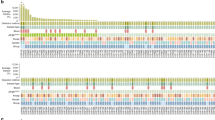Abstract
Prolactinomas, or prolactin-secreting adenomas, constitute the most common type of hyperfunctioning pituitary adenoma. Dopamine agonists are used as first-line medication for prolactinomas, but the tumors are resistant to the therapy in 5–18 % of patients. To explore potential mechanisms of resistance to bromocriptine (a dopamine agonist), we analyzed six responsive prolactinomas and six resistant prolactinomas by whole-exome sequencing. We identified ten genes with sequence variants that were differentially found in the two groups of tumors. The expression of these genes was then quantified by real-time reverse-transcription PCR (RT-qPCR) in the 12 prolactinomas and in six normal pituitary glands. The mRNA levels of one of the genes, PRB3, were about fourfold lower in resistant prolactinomas than in the responsive tumors (p = 0.02). Furthermore, low PRB3 expression was also associated with tumor recurrence. Our results suggest that low levels of PRB3 mRNA may have a role in dopamine-agonist resistance and tumor recurrence of prolactinomas.


Similar content being viewed by others
References
Gillam MP, Molitch ME, Lombardi G, Colao A (2006) Advances in the treatment of prolactinomas. Endocr Rev 27:485–534. doi:10.1210/er.2005-9998
Iyer P, Molitch ME (2011) Positive prolactin response to bromocriptine in 2 patients with cabergoline-resistant prolactinomas. Endocr Pract 17:e55–e58. doi:10.4158/EP10369.CR
Molitch ME (2005) Pharmacologic resistance in prolactinoma patients. Pituitary 8:43–52. doi:10.1007/s11102-005-5085-2
Oh MC, Aghi MK (2011) Dopamine agonist-resistant prolactinomas. J Neurosurg 114:1369–1379. doi:10.3171/2010.11.jns101369
Wu ZB, Zheng WM, Su ZP, Chen Y, Wu JS, Wang CD, Lin C, Zeng YJ, Zhuge QC (2010) Expression of D2RmRNA isoforms and ERmRNA isoforms in prolactinomas: correlation with the response to bromocriptine and with tumor biological behavior. J Neurooncol 99:25–32. doi:10.1007/s11060-009-0107-y
Liu X, Ma S, Yao Y, Li G, Feng M, Deng K, Dai C, Cai F, Li Y, Zhang B, Wang R (2012) Differential expression of folate receptor alpha in pituitary adenomas and its relationship to tumor behavior. Neurosurgery 70:1274–1280. doi:10.1227/NEU.0b013e3182417e76; discussion 1280
Yang F, Zhang L, Huo XS, Yuan JH, Xu D, Yuan SX, Zhu N, Zhou WP, Yang GS, Wang YZ, Shang JL, Gao CF, Zhang FR, Wang F, Sun SH (2011) Long noncoding RNA high expression in hepatocellular carcinoma facilitates tumor growth through enhancer of zeste homolog 2 in humans. Hepatology 54:1679–1689. doi:10.1002/hep.24563
Hoischen A, van Bon BW, Gilissen C, Arts P, van Lier B, Steehouwer M, de Vries P, de Reuver R, Wieskamp N, Mortier G, Devriendt K, Amorim MZ, Revencu N, Kidd A, Barbosa M, Turner A, Smith J, Oley C, Henderson A, Hayes IM, Thompson EM, Brunner HG, de Vries BB, Veltman JA (2010) De novo mutations of SETBP1 cause Schinzel–Giedion syndrome. Nat Genet 42:483–485. doi:10.1038/ng.581
Lu R, Gao H, Wang H, Cao L, Bai J, Zhang Y (2013) Overexpression of the Notch3 receptor and its ligand Jagged1 in human clinically non-functioning pituitary adenomas. Oncol Lett 5:845–851. doi:10.3892/ol 2013.1113
Pellegrini I, Rasolonjanahary R, Gunz G, Bertrand P, Delivet S, Jedynak CP, Kordon C, Peillon F, Jaquet P, Enjalbert A (1989) Resistance to bromocriptine in prolactinomas. J Clin Endocrinol Metab 69:500–509
Kukstas LA, Domec C, Bascles L, Bonnet J, Verrier D, Israel JM, Vincent JD (1991) Different expression of the two dopaminergic D2 receptors, D2415 and D2444, in two types of lactotroph each characterised by their response to dopamine, and modification of expression by sex steroids. Endocrinology 129:1101–1103
Caccavelli L, Feron F, Morange I, Rouer E, Benarous R, Dewailly D, Jaquet P, Kordon C, Enjalbert A (1994) Decreased expression of the two D2 dopamine receptor isoforms in bromocriptine-resistant prolactinomas. Neuroendocrinology 60:314–322
Azen E, Prakobphol A, Fisher SJ (1993) PRB3 null mutations result in absence of the proline-rich glycoprotein Gl and abolish Fusobacterium nucleatum interactions with saliva in vitro. Infect Immun 61:4434–4439
Scully C, Bagan JV, Hopper C, Epstein JB (2008) Oral cancer: current and future diagnostic techniques. Am J Dent 21:199–209
Raponi M, Zhang Y, Yu J, Chen G, Lee G, Taylor JM, Macdonald J, Thomas D, Moskaluk C, Wang Y, Beer DG (2006) Gene expression signatures for predicting prognosis of squamous cell and adenocarcinomas of the lung. Cancer Res 66:7466–7472. doi:10.1158/0008-5472.CAN-06-1191
Warner TF, Azen EA (1988) Tannins, salivary proline-rich proteins and oesophageal cancer. Med Hypotheses 26:99–102
Pellegrini-Bouiller I, Morange-Ramos I, Barlier A, Gunz G, Figarella-Branger D, Cortet-Rudelli C, Grisoli F, Jaquet P, Enjalbert A (1996) Pit-1 gene expression in human lactotroph and somatotroph pituitary adenomas is correlated to D2 receptor gene expression. J Clin Endocrinol Metab 81:3390–3396
Delgrange E, Sassolas G, Perrin G, Jan M, Trouillas J (2005) Clinical and histological correlations in prolactinomas, with special reference to bromocriptine resistance. Acta neurochir 147:751–757. doi:10.1007/s00701-005-0498-2; discussion 757–758
Raverot G, Wierinckx A, Dantony E, Auger C, Chapas G, Villeneuve L, Brue T, Figarella-Branger D, Roy P, Jouanneau E, Jan M, Lachuer J, Trouillas J (2010) Prognostic factors in prolactin pituitary tumors: clinical, histological, and molecular data from a series of 94 patients with a long postoperative follow-up. J Clin Endocrinol Metab 95:1708–1716. doi:10.1210/jc.2009-1191
Dehdashti AR, Ganna A, Karabatsou K, Gentili F (2008) Pure endoscopic endonasal approach for pituitary adenomas: early surgical results in 200 patients and comparison with previous microsurgical series. Neurosurgery 62:1006–1015. doi:10.1227/01.neu.0000325862.83961.12; discussion 1015–1007
Author information
Authors and Affiliations
Corresponding author
Additional information
Fei Wang and Hua Gao have contributed equally to this work.
Electronic supplementary material
Below is the link to the electronic supplementary material.
Rights and permissions
About this article
Cite this article
Wang, F., Gao, H., Li, C. et al. Low levels of PRB3 mRNA are associated with dopamine-agonist resistance and tumor recurrence in prolactinomas. J Neurooncol 116, 83–88 (2014). https://doi.org/10.1007/s11060-013-1276-2
Received:
Accepted:
Published:
Issue Date:
DOI: https://doi.org/10.1007/s11060-013-1276-2




